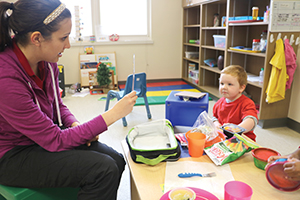By BETSY TAYLOR
CREVE COEUR, Mo. —
Three-year-old Charlie Siders is having a rough afternoon as he arrives in tears at the Mercy Kids Autism Center in St. Louis County. He is potty training, and doing well with it overall, but today needs a change out of his wet clothes. His mother Mackenzie Siders, 39, remains unruffled.

Claire Karlen, a registered behavior technician at Mercy Kids Autism Center in Creve Coeur, Mo., makes eye contact with Charlie Siders, 3, and asks if he'd like a utensil to help him eat his snack. Charlie is in an intensive early intervention program at the center. Photo by Betsy Taylor
Siders, a mother of five, and LenEll Kelley, a board certified behavior analyst, stay with Charlie while he cries. Siders later explains they gently comforted him, praising him whenever his cries stopped for a quick gasp of air. Every time he tried to regain his composure, they acknowledged it until he was able to stop crying after several minutes.
Charlie is one of 13 children in Mercy Kids Autism Center's Intensive Early Intervention Program for children between the ages of about one and a half to 5. The program, which opened to five children in 2010, is in the process of expanding to serve 20 children this year. Foundation gifts and other grants are helping fund the expansion.
Baby monitors
In September, the center began piloting an infant monitoring program. Participating babies, all of whom have a sibling on the autism spectrum, are evaluated at least monthly for signs of autism or other developmental delays, says Kelly Wooldridge, manager of therapy services for Mercy St. Louis. Babies can be enrolled in the monitoring program at 6 months and will age out at 36 months.
While the causes of autism aren't known, research has established that younger siblings of children with autism have a roughly 20 percent chance of being on the autism spectrum, from mild to severe. Experts say autism strikes about one in 100 people, with about one in 68 boys and one in 200 girls diagnosed as being on the autism spectrum.
Autism spectrum disorders are a group of neurodevelopmental disorders characterized by impaired social interaction, reduced verbal and nonverbal communication, and by repetitive behaviors.
Mercy clinicians started the infant monitoring program for the earliest possible recognition of children with delays in order to educate their parents and to begin developmental therapies as quickly as possible.

Charlie's dad, Ben Siders, lifts his son in the air at an O'Fallon, Mo., park. Photo by Holly Thompson
Mercy clinicians recommend social attachment and early language interventions for those in the infant monitoring program exhibiting symptoms of autism or other significant developmental impairments. Studies in toddlers and young children have indicated that early intervention leads to better functional outcomes in children with autism spectrum disorders.
Research shows that early intervention can positively change the way the brain functions in children with autism, said health care providers involved with the early intervention program.
However, there is not yet sufficient evidence-based research to know if early interventions will improve outcomes for babies as young as those beginning in the infant monitoring program, explains Dr. John Mantovani. The pediatric neurologist is the medical director of Mercy Kids Autism Center, and he chairs pediatrics for Mercy Children's Hospital.
Playing with others
Siders says the Intensive Early Intervention Program has been life-changing for Charlie, who is better able to express himself and interact with others. He began the program at 20 months of age. She says the therapists working with Charlie are extraordinary. "I feel Charlie has been given his best possible start."
During the recent visit, once Charlie is changed into his dry clothes, he's downright sunny. He joins three other boys for circle time, where they listen to the story of The Gingerbread Man.
Speech therapist Whitney Wojahn explains later that there's a lot more than a shared story going on here: Learning together in a group setting, the children practice social skills with one another. They develop motor skills as they mold sculpting clay into characters from the book. As Wojahn reads, she asks the children to identify items on the illustrated pages in the book, and answer questions about the story. This improves language and comprehension skills.
She invites the kids to share an elbow bump when they like another's response. That, she says, provides social reinforcement, and also: "They just think it's funny and fun."
Each child works with a team that includes a lead therapist. That role can be assigned to an occupational therapist, a speech language pathologist or a certified behavior analyst. As many as four therapists may work with one child in a given day. Both a physical therapist and a dietitian consult as needed on each child's care. The therapists work with the children on specific skills and track progress. Parents are strongly encouraged to attend sessions of the early intervention program, so they can learn and reinforce the behavior modification techniques.

The Siders in a family portrait. The top row shows, left, 18-year-old Spencer and father Ben Siders. The bottom row, from left, includes then-8-year-old Anneliese; mother Mackenzie with Charlie on her lap, 7-year-old Maggie and 6-year-old Hayden. Photo by Holly Thompson
Diagnosing autism
Clinicians evaluate behavior to make an autism diagnosis. Charlie had developmental delays as an infant and wasn't walking at 15 months. However, his mother says, he often didn't have to, as others in the house would help him out when he needed something. His pediatrician suspected autism. But physical therapists treating Charlie's developmental delays thought otherwise. His parents continued to pursue answers, and, when Charlie was 18 months old, Mantovani made a definitive diagnosis of autism.
"You get the diagnosis. Now we know. What do we do? Nobody tells you that," says Siders. She said she felt like she was constantly reacting to new information, rather than taking proactive steps to aid in Charlie's development.
Intensive intervention for multiple impairments
The Siders heard about the early intervention program during Charlie's visits to see health care providers at Mercy Hospital St. Louis. When a spot opened in that program in November of 2014, within two months of Charlie's diagnosis, Siders and her husband talked about whether they could afford it. The program costs $1,500 a month and is offered on a self-pay basis. Costs are subsidized more than 50 percent by Mercy Hospital and Mercy Health Foundation support.
The Siders explored less costly therapy options before deciding to try the program for six months. In retrospect, the couple is certain it was the right decision for Charlie.
Mercy Kids Autism Center employs the Early Start Denver Model, a comprehensive intervention for children from age 12 months to 48 months. The early intervention program at Mercy includes a few children up to age 5 if their overall development level is less than 48 months, Mantovani said. Therapists draw from each child's own interests to help the child build his or her interaction and communication abilities.
Participants come to Mercy's early intervention program four times a week, for a half day together each time.
A child who is at least 3 and has met defined skill requirements in the Early Start Denver Model transitions to a twice weekly bridge program, which costs $750 a month. It prepares children to move to an early childhood special education program matched to their individual needs and capabilities, says Wooldridge.
Building on interests
Parents learn alongside their children at the Mercy Kids Autism Center. For example, Siders says that at home Charlie loves to spin pot and pan lids, flipping them on their edges to make them twirl or teeter. She used to discourage him.
Therapists from the early intervention program taught her how to take what Charlie was doing and use it to build on his interpersonal skills. For example, Charlie's therapist encouraged him to make eye contact with her as she spun a lid, or placed it atop her head.
Slowly, with months of work, Charlie has become better able to interact and communicate with those around him. Therapists work on other skills with him as well; he can write his name and count past 20. Siders credits the intensive therapy for this progress.
"His ability to connect with people is fantastic," his mother says.
Copyright © 2017 by the Catholic Health Association
of the United States
For reprint permission, contact Betty Crosby or call (314) 253-3490.